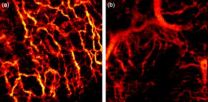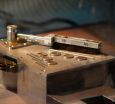(Press-News.org)
VIDEO:
This is a 2x2x2mm extracted blood vessel structure of basal cell carcinoma in vivo exhibiting a chaotic vascular pattern (left). Virtually cut volume obtained with OCT displaying the embedded blood...
Click here for more information.
WASHINGTON, Sept. 24, 2012—The trained eye of a dermatologist can identify many types of skin lesions, but human sight only goes so far. Now an international team of researchers has developed an advanced optics system to noninvasively map out the network of tiny blood vessels beneath the outer layer of patients' skin, potentially revealing telltale signs of disease. Such high resolution 3-D images could one day help doctors better diagnose, monitor, and treat skin cancer and other skin conditions. The research was published today in the Optical Society's (OSA (http://www.osa.org)) open-access journal Biomedical Optics Express (http://www.opticsinfobase.org/boe).
VIDEO:
This is a 2x2x2mm extracted blood vessel structure in 3-D of healthy skin in vivo obtained with the label-free optical motion contrast method (left). Virtually cut volume obtained with OCT...
Click here for more information.
Researchers from Medical University Vienna (MUW) in Austria and the Ludwig-Maximilians University in Munich, Germany, used a technique called optical coherence tomography (OCT) to "see" beneath the surface of skin. The researchers tested their system on a range of different skin conditions, including a healthy human palm, allergy-induced eczema on the forearm, dermatitis on the forehead, and two cases of basal cell carcinoma – the most common type of skin cancer – on the face. Compared to healthy skin, the network of vessels supplying blood to the tested lesions showed significantly altered patterns. "The condition of the vascular network carries important information on tissue health and its nutrition," says Rainer Leitgeb, a researcher at MUW and the study's principal investigator. "Currently, the value of this information is not utilized to its full extent."
Ophthalmologists have used OCT since the 1990s to image different parts of the eye and the technology has recently attracted increased interest from dermatologists. OCT has many advantages over other imaging techniques: It is non-invasive and provides high-resolution images at high speed. OCT is typically used to show tissue structure, but it can also reveal the pattern of blood vessels, which carry important clues about disease, by capitalizing on the unique optical properties of flowing blood cells.
The researchers at MUW are the first to use OCT to visualize the network of blood vessels in human skin that feed cancerous skin lesions. To maximize the quality of the images the team employed a high-tech laser light source developed by collaborators from the Ludwig-Maximilians University. The laser enabled unprecedented high-speed imaging and operated at a near-infrared wavelength that gave better penetration into skin tissue.
"High speed is of paramount importance in order to image lesions in vivo and in situ while minimizing the effect of involuntary patient motion," explains researcher Cedric Blatter of MUW. The device also shapes the light in a special way forming a Bessel beam, which can reform, or heal, its shape even if portions of it are blocked. The beam enabled the researchers to keep the images in focus across a depth range of approximately 1 millimeter.
The team's images of basal cell carcinoma showed a dense network of unorganized blood vessels, with large vessels abnormally close to the skin surface. The larger vessels branch into secondary vessels that supply blood to energy-hungry tumor regions. The images, together with information about blood flow rates and tissue structure, could yield important insights into the metabolic demands of tumors during different growth stages.
The imaging system shows the most promise for clinical application in the diagnosis and treatment of skin cancer, the researchers believe. "We hope that improved in-depth diagnosis of tissue alterations due to disease might help to reduce the number of biopsies by providing better guidance," says Leitgeb. The system could also be used by doctors to assess how quickly a tumor is likely to grow and spread, as well as to monitor the effectiveness of treatments such as topical chemotherapy. "Treatment monitoring may also be expanded toward inflammatory and auto-immune related dermatological conditions," Blatter notes.
Going forward, the researchers would like to increase the field of view of the device so that they can image the full lesion along with its border to healthy tissue. They are also working on speeding up the post-processing of the optical signal to enable live vasculature display, and improving the portability of the system, which currently occupies an area about half the size of an office desk. "We believe that in the future our method will help to simplify non-invasive dermatological in vivo diagnostics and allow for in-depth treatment monitoring," says Blatter.
INFORMATION:
Paper: "In-situ Structural and Microangiographic Assessment of Human Skin Lesions with High-speed OCT (http://www.opticsinfobase.org/boe/abstract.cfm?uri=boe-3-10-2636)," Biomedical Optics Express, Vol. 3, Issue 10, pp. 2636-2646 (2012).
EDITOR'S NOTE: High-resolution images and animation are available to members of the media upon request. Contact Angela Stark, astark@osa.org.
About Biomedical Optics Express
Biomedical Optics Express is OSA's principal outlet for serving the biomedical optics community with rapid, open-access, peer-reviewed papers related to optics, photonics and imaging in the life sciences. The journal scope encompasses theoretical modeling and simulations, technology development, and biomedical studies and clinical applications. It is published by the Optical Society and edited by Joseph A. Izatt of Duke University. Biomedical Optics Express is an open-access journal and is available at no cost to readers online at http://www.OpticsInfoBase.org/BOE.
About OSA
Uniting more than 180,000 professionals from 175 countries, the Optical Society (OSA) brings together the global optics community through its programs and initiatives. Since 1916 OSA has worked to advance the common interests of the field, providing educational resources to the scientists, engineers and business leaders who work in the field by promoting the science of light and the advanced technologies made possible by optics and photonics. OSA publications, events, technical groups and programs foster optics knowledge and scientific collaboration among all those with an interest in optics and photonics. For more information, visit www.osa.org.
Tissues tell the tale: Non-invasive optical technique detects cancer by looking under the skin
European researchers image blood vessels that feed skin cancer with OCT for the first time
2012-09-24
ELSE PRESS RELEASES FROM THIS DATE:
Heritability of avoidant and dependent personality disorder traits
2012-09-24
A new twin study from the Norwegian Institute of Public Health shows that the heritability of avoidant and dependent personality disorder traits might be higher than previously reported. People with avoidant personality disorder are often anxious in the company of others, while people with dependent personality disorder feel more secure.
Results from previous studies indicate that genetic factors explain about one third of the individual differences in these personality disorder traits, while the remaining variation is best explained by environmental influences. These ...
Newly discovered molecule could deliver drugs to treat diseases
2012-09-24
MANHATTAN, Kan. -- Kansas State University researchers have discovered a molecule that may be capable of delivering drugs inside the body to treat diseases.
For the first time, researchers have designed and created a membrane-bounded vesicle formed entirely of peptides -- molecules made up of amino acids, the building blocks of protein. The membrane could serve as a new drug delivery system to safely treat cancer and neurodegenerative diseases.
A study led by John Tomich, professor of biochemistry at Kansas State University, has been published in the journal PLOS ONE ...
A windshield wiper for Mars dust is developed
2012-09-24
This press release is available in Spanish.
VIDEO:
A team of researchers at Universidad Carlos III in Madrid has developed a device that works as a windshield wiper to eliminate Mars dust from the sensors on the NASA...
Click here for more information.
Leading energy scientists from the UK and China are joining forces to develop green technology that will revolutionise the way electricity ...
Gas outlets off Spitsbergen are no new phenomenon
2012-09-24
Frequent storms and sub-zero temperatures – nature drove the marine researchers that were assessing gas outlets on the sea bed off the coast of Spitsbergen for four and a half weeks to their limits. Nevertheless the participants were very pleased when they returned: "We were able to gather many samples and data in the affected area. With the submersible JAGO we even managed to form an impression of the sea bed and the gas vents" summarised the chief scientist Professor Dr. Christian Berndt from GEOMAR | Helmholtz Centre for Ocean Research Kiel.
The reason for the expedition ...
Therapeutic impact of cell transplantation aided by magnetic factor
2012-09-24
Putnam Valley, NY. (Sept. 24, 2012) – Two studies in the current issue of Cell Transplantation (21:6), now freely available on-line at http://www.ingentaconnect.com/content/cog/ct/, demonstrate how the use of magnetic particles are a factor that can positively impact on the targeted delivery of transplanted stem cells and to also provide better cell retention.
A research team from the University of British Columbia used focused magnetic stem cell targeting to improve the delivery and transport of mensenchymal stem cells to the retinas of test rats while researchers from ...
In birds' development, researchers find diversity by the peck
2012-09-24
Cambridge, Mass. - September 24, 2012 - It has long been known that diversity of form and function in birds' specialized beaks is abundant. Charles Darwin famously studied the finches on the Galapagos Islands, tying the morphology (shape) of various species' beaks to the types of seeds they ate. In 2010, a team of Harvard biologists and applied mathematicians showed that Darwin's finches all actually shared the same developmental pathways, using the same gene products, controlling just size and curvature, to create 14 very different beaks.
Now, expanding that work to ...
Scientists shed light on riddle of sun's explosive events
2012-09-24
DURHAM, N.H. – Four decades of active research and debate by the solar physics community have failed to bring consensus on what drives the sun's powerful coronal mass ejections (CMEs) that can have profound "space weather" effects on Earth-based power grids and satellites in near-Earth geospace.
In a paper just published in Nature Physics, an international team of space scientists, including a researcher from the University of New Hampshire's Space Science Center (SSC), explains the mysterious physical mechanisms underlying the origin of CMEs. Their findings, based on ...
When they do not all look alike: Using identity to reduce own-race bias
2012-09-24
September 24, 2012 - People often remark that people of a different race "all look alike." However, when we have trouble recognizing people from another race, it may actually have little to do with the other person's race. Instead, new research finds that that we can improve our memory of members of another race by identifying ourselves as part of the same group. Such identification could improve everything from race relations to eyewitness identification.
"One of the most robust phenomena in social perception is the finding that people are better at remembering people ...
Little evidence supports medical treatment options for adolescents with autism
2012-09-24
Vanderbilt University researchers are reporting today that there is insufficient evidence to support the use of medical interventions in adolescents and young adults with autism.
Despite studies that show that many adolescents and young adults with autism spectrum disorders are being prescribed medications, there is almost no evidence to show whether these medications are helpful in this population, the researchers said.
These findings are featured in the Sept. 24 issue of Pediatrics.
"We need more research to be able to understand how to treat core symptoms of autism ...
Media coverage influences value of presidential debates for viewers, study finds
2012-09-24
COLUMBUS, Ohio -- The presidential debates offer viewers a lot of substance about the issues of the campaign -- but postdebate media coverage can undermine the value they have for voters, a new study suggests.
Results showed that postdebate coverage that focused on the debate as a competition led viewers to think less about policy issues. By comparison, coverage that focused on the substance of the discussion increased the likelihood that viewers would come away with specific thoughts about candidates' policy proposals.
The researchers conducted two different studies ...
LAST 30 PRESS RELEASES:
Making lighter work of calculating fluid and heat flow
Normalizing blood sugar can halve heart attack risk
Lowering blood sugar cuts heart attack risk in people with prediabetes
Study links genetic variants to risk of blinding eye disease in premature infants
Non-opioid ‘pain sponge’ therapy halts cartilage degeneration and relieves chronic pain
AI can pick up cultural values by mimicking how kids learn
China’s ecological redlines offer fast track to 30 x 30 global conservation goal
Invisible indoor threats: emerging household contaminants and their growing risks to human health
Adding antibody treatment to chemo boosts outcomes for children with rare cancer
Germline pathogenic variants among women without a history of breast cancer
Tanning beds triple melanoma risk, potentially causing broad DNA damage
Unique bond identified as key to viral infection speed
Indoor tanning makes youthful skin much older on a genetic level
Mouse model sheds new light on the causes and potential solutions to human GI problems linked to muscular dystrophy
The Journal of Nuclear Medicine ahead-of-print tip sheet: December 12, 2025
Smarter tools for peering into the microscopic world
Applications open for funding to conduct research in the Kinsey Institute archives
Global measure underestimates the severity of food insecurity
Child survivors of critical illness are missing out on timely follow up care
Risk-based vs annual breast cancer screening / the WISDOM randomized clinical trial
University of Toronto launches Electric Vehicle Innovation Ontario to accelerate advanced EV technologies and build Canada’s innovation advantage
Early relapse predicts poor outcomes in aggressive blood cancer
American College of Lifestyle Medicine applauds two CMS models aligned with lifestyle medicine practice and reimbursement
Clinical trial finds cannabis use not a barrier to quitting nicotine vaping
Supplemental nutrition assistance program policies and food insecurity
Switching immune cells to “night mode” could limit damage after a heart attack, study suggests
URI-based Global RIghts Project report spotlights continued troubling trends in worldwide inhumane treatment
Neutrophils are less aggressive at night, explaining why nighttime heart attacks cause less damage than daytime events
Menopausal hormone therapy may not pose breast cancer risk for women with BRCA mutations
Mobile health tool may improve quality of life for adolescent and young adult breast cancer survivors
[Press-News.org] Tissues tell the tale: Non-invasive optical technique detects cancer by looking under the skinEuropean researchers image blood vessels that feed skin cancer with OCT for the first time


